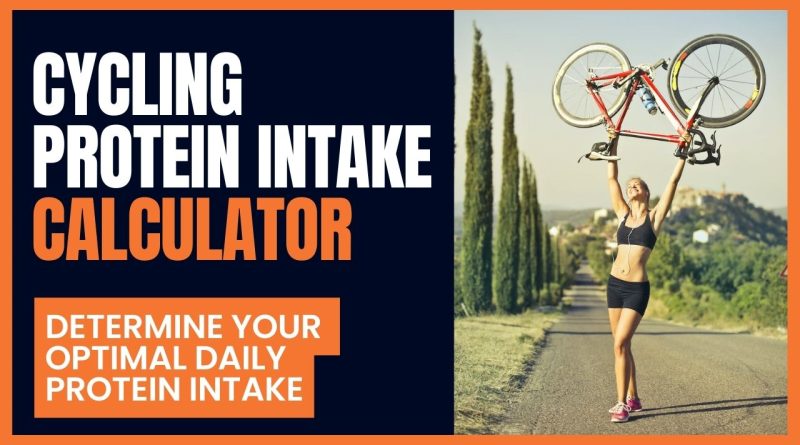Cycling Protein Intake Calculator
Use our Cycling Protein Intake Calculator to determine your optimal daily protein intake based on factors such as gender, age, height, weight, and cycling discipline. Whether you’re a recreational cyclist or a competitor in road cycling, mountain biking, or BMX, our calculator helps you find the right amount of protein to support your body’s recovery and performance.
keep on reading after the calculator to see our in-depth guide to how protein can benefit cyclists.
Cycling Protein Intake Calculator
Note: This calculator aims to give you a starting point for your protein intake needs. If you are unsure please speak to a professional.
Disclaimer: The information provided by this Cycling Protein Intake Calculator is intended for general informational and educational purposes only. It should not be construed as medical or professional advice. Always consult with a healthcare professional or a registered dietitian before making any significant changes to your diet or exercise routine.
- Cycling Protein Intake Calculator
- What is Protein?
- Protein Intake for Male and Female Cyclists
- Protein Intake and Age
- Protein Timing: Before or After Cycling?
- Pre-Bed Protein Intake for Cyclists
- The Role of Essential Amino Acids
- Protein's Role in Weight Loss
- Protein Intake During Endurance Training or Competition
- Plant-based Protein Sources for Cyclists
- Protein Supplementation for Cyclists
- Protein Intake for Recovery from Injury
- The Role of Protein in Hydration and Electrolyte Balance
- Protein and Overtraining Syndrome
- Strategies for Meeting Protein Needs on Long Rides
- Final thoughts
What is Protein?
Protein is an essential nutrient that plays a vital role in our health and physical performance. It supports numerous functions in our body, such as maintaining a stable immune system and assisting in muscle repair and growth. For cyclists, protein is particularly crucial during recovery to prevent muscle breakdown and promote muscle repair.

Protein Intake for Male and Female Cyclists
The same protein recommendations apply to both male and female cyclists, with a daily intake of about 1.6 to 1.8 grams per kilogram of body weight for adults training between 1 and 3 hours per day. However, since women generally weigh less than men, their absolute protein intake will be lower. Some studies suggest that protein requirements may differ during various phases of the menstrual cycle, but further research is needed. Study here.
Protein Intake and Age
Protein requirements can vary depending on factors such as age, diet, and training volume. Younger cyclists may require more protein to support growth and development, while older riders may need slightly higher protein intake to maintain muscle mass and strength.
A study here if you would like to learn more.
Protein Timing: Before or After Cycling?
While the exact timing of protein intake may not be critical, consuming protein after a long or intense cycling session can support post-workout recovery and adaptation processes. Ideally, protein should be distributed evenly throughout the day, with 0.3 to 0.4 grams of protein per kilogram of body weight consumed at each meal.
Pre-Bed Protein Intake for Cyclists
Consuming protein before bed can help support muscle repair and growth overnight. This can be particularly beneficial for cyclists with high training volumes or those looking to optimize body composition.
The Role of Essential Amino Acids
A sufficient intake of all nine essential amino acids is crucial for optimal health and muscle function. Leucine, in particular, is vital for activating muscle repair and building processes. Good sources of protein include animal products like eggs, dairy, and meat, as well as plant-based options such as legumes, nuts, seeds, and cereals.
Protein’s Role in Weight Loss
Higher protein intake during a calorie-restricted diet can help increase body fat loss while preserving muscle mass. Protein is more filling than carbohydrates and fats, and its metabolism and digestion require more energy, contributing to a higher thermogenic effect.
Protein Intake During Endurance Training or Competition
Although there is no evidence that protein intake during endurance exercise improves performance compared to adequate carbohydrate intake, it can help replace amino acids used for energy and speed up recovery. This may be particularly helpful during ultra-endurance events, where protein can account for 5-10% of total energy supply. However, individual tolerance to protein intake during exercise should be considered to avoid gastrointestinal issues.
You might find helpful: Bike Calorie and Hydration Calculator

Plant-based Protein Sources for Cyclists
Cyclists who follow a plant-based diet can still meet their protein needs by consuming a variety of protein-rich plant foods. Some of the best plant-based protein sources include:
- Lentils: 18 grams of protein per cooked cup
- Tofu: 10-12 grams of protein per 3.5 ounces (100 grams)
- Tempeh: 19 grams of protein per 3.5 ounces (100 grams)
- Quinoa: 8 grams of protein per cooked cup
- Chia seeds: 5 grams of protein per 2 tablespoons
Incorporating these protein sources into your daily meals will help ensure that you receive the essential amino acids required for optimal muscle function and recovery.
Protein Supplementation for Cyclists
Although many cyclists can meet their protein needs through a balanced diet, some may benefit from protein supplements, especially during periods of high training volume or when trying to optimize body composition. Some popular protein supplements include:
- Whey protein: Derived from milk, whey protein is quickly absorbed and rich in essential amino acids, making it an excellent choice for post-workout recovery.
- Casein protein: Also derived from milk, casein protein is absorbed more slowly, providing a sustained release of amino acids. It can be beneficial for overnight muscle recovery.
- Plant-based protein powders: Made from sources like peas, rice, or hemp, these are ideal options for those who follow a vegan or vegetarian diet. Choose a blend of plant proteins to ensure a complete amino acid profile.
It’s essential to remember that protein supplements should not replace whole foods but rather complement a balanced diet to help meet protein needs.
Protein Intake for Recovery from Injury
During injury recovery, protein intake becomes even more critical, as it plays a vital role in tissue repair and regeneration. Cyclists recovering from an injury should aim for a slightly higher protein intake, around 2.0 grams per kilogram of body weight per day. Consuming a mix of both animal and plant-based protein sources can help ensure a complete amino acid profile for optimal healing.
The Role of Protein in Hydration and Electrolyte Balance
Protein intake can influence hydration and electrolyte balance, as it affects fluid balance within the body. Consuming protein-rich foods can increase urine production, potentially leading to dehydration if fluid intake is not sufficient. It’s essential for cyclists to monitor their hydration levels and consume adequate fluids, especially when increasing protein intake. Additionally, maintaining a balanced intake of electrolytes, such as sodium, potassium, and magnesium, is crucial for proper muscle function and overall health.
Protein and Overtraining Syndrome
Inadequate protein intake can contribute to overtraining syndrome in cyclists by impairing muscle recovery and adaptation. When protein intake is insufficient, the body may struggle to repair damaged muscle tissue, leading to increased fatigue, reduced performance, and a heightened risk of injury. To prevent overtraining, cyclists should ensure they consume adequate protein, along with proper rest and a well-rounded training program.
Strategies for Meeting Protein Needs on Long Rides
To meet protein needs during long rides or multi-day cycling events, consider these practical strategies:
- Pack protein-rich snacks: Bring along portable protein sources, such as nuts, seeds, protein bars, or nut butter packets, for easy consumption during breaks.
- Plan meals ahead: If stopping for meals during your ride, research dining options that offer protein-rich choices to meet your needs.
- Use protein supplements: Carry single-serve protein powder packets or ready-to-drink protein shakes for a quick and convenient protein boost during your ride.
- Opt for electrolyte drinks with added protein: Some sports drinks contain a small amount of protein, which can contribute to meeting your protein needs during long rides. These drinks can help replenish electrolytes while also providing a small but steady supply of protein throughout your ride.
- Post-ride recovery: After completing a long ride, prioritize consuming a protein-rich meal or snack within 1-2 hours to support muscle recovery and repair. Options could include a protein shake, Greek yogurt with fruit, or a sandwich with lean protein.
- Combine carbohydrates and protein: During multi-day events, focus on consuming a mix of carbohydrates and protein to support energy levels and muscle recovery. Aim for a 3:1 or 4:1 carbohydrate-to-protein ratio in your post-ride meals and snacks.
By incorporating these strategies, cyclists can effectively meet their protein needs during long rides and multi-day cycling events, supporting muscle recovery and maintaining peak performance.
Final thoughts
In conclusion, both male and female cyclists should prioritize protein intake for optimal muscle recovery, growth, and overall health. Distributing protein evenly throughout the day and incorporating a variety of animal and plant-based sources will ensure adequate essential amino acids. Always consider individual needs, training volume, and dietary preferences to tailor protein strategies effectively.
You may also like:




